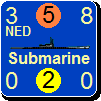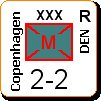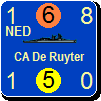warspite1
Posts: 41353
Joined: 2/2/2008
From: England
Status: offline

|
Here is the first of the revised Dutch write-ups:
[4746 De Ruyter]
.B Engine(s) output: 66,000 shp
.B Top Speed: 32 knots
.B Main armament: 7 x 5.9-inch (150mm), 10 x 40mm guns
.B Displacement (Full Load): 7,548 tons
.B Thickest armour: 2-inch (Belt), 1.2-inch (Deck), 1.2-inch (Turrets)
.P The Dutch Navy’s principal role prior to the outbreak of the Second World War was the protection of her main overseas possession, the Dutch East Indies (NEI). The NEI (modern day Indonesia) provided the Netherlands with oil and other raw materials to meet not only her own requirements, but also provided her with vital export income.
.P In 1930, to counter the growing threat posed by the Japanese to this important colony, the Dutch considered that a force of three cruisers, twelve destroyers and eighteen submarines was the minimum requirement for the NEI station. With the cancellation of the cruiser Celebes after the end of World War I, the Dutch required a third cruiser to complement the cruisers Java and Sumatra already on station.
.P The design chosen was typical of so many warships constructed during the years between the two world wars. There was neither the money available nor the political will for the construction of expensive warships and the result was a cruiser that would prove woefully inadequate when war came a decade later.
.P The cruiser, named De Ruyter, was finally ordered in 1932 and laid down a year later. She was launched in 1935 and completed in October 1936.
.P She was to have been limited to just 5,250 tons (similar to the British Arethusas – themselves an experiment in building the smallest practical cruiser) although during the construction phase there was some fiscal relaxation allowed and she eventually weighed in at 6,000 tons (standard).
.P The extra weight allowed an increase in length and an additional, single, superfiring 5.9-inch "B" turret to add to the three twin 5.9-inch guns originally envisaged. Although she benefitted from a modern fire control system, the main armament was inadequate when compared with her Japanese contemporaries.
.P De Ruyter’s anti-aircraft (AA) armament of five, twin 40mm bofors was oddly arranged with all five mounts being concentrated aft. This arrangement not only gave limited arcs of fire but also meant the entire AA defence could be wiped out with one bomb or shell hit.
.P As part of the cost saving exercise, De Ruyter was not fitted with torpedoes tubes. She was given a catapult and could carry up to two aircraft.
.P Her top speed was 32 knots and she was fitted with an overload feature that could increase her speed to 33.5 knots for short periods.
.P Her defensive armour consisted of a belt that ranged from 1.2 to 2-inches thick, with 1.2-inch bulkheads and a protective deck of similar thickness.
.P De Ruyter was named after Michiel de Ruyter, arguably Holland’s most well known admiral, famous for his exploits during the Anglo-Dutch wars of the 17th Century.
.P Upon commissioning into the Dutch Navy, De Ruyter sailed almost immediately for the Far East where she arrived in March 1937.
.P When Holland was defeated by the Germans in May 1940, Dutch shipping in European waters was placed under the control of the Admiralty, although this did not apply to the forces guarding the NEI and the naval forces there continued operating under Dutch control.
.P In response to the Japanese attack on Pearl Harbor and Malaya in December 1941, the Dutch declared war on Japan the following day. De Ruyter and other Dutch ships initially assisted the passage of British convoys to Malaya and Singapore – the northern end of the “Malay Barrier”.
.P The Allied defences in Malaya and the Philippines quickly unwound and important, irreplaceable, assets were lost – two Royal Navy capital ships were lost off the Malayan coast, and the bulk of the United States Far East Air Force was destroyed on the ground in the Philippines.
.P Following this calamitous start to the war with Japan, the remaining American, British, Dutch and Australian assets were brought together under "ABDA" command on the 10th January 1942. The naval component was designated ABDAFLOAT and was commanded by Admiral Thomas Hart (USN) with the Royal Navy’s Rear-Admiral Arthur Palliser as his Chief of Staff (see HNLMS Sumatra for further detail on the Dutch Navy in the Far East).
.P On the 1st February 1942 Admiral Hart ordered the formation of the ABDA Combined Striking Force. This force would be used to try and intercept and destroy Japanese invasion convoys. The Dutchman, Rear-Admiral Karel Doorman was placed in command of the task force and this first went into action on the 4th February 1942. Doorman led a mixed US/Dutch force that, in addition to De Ruyter, consisted of the cruisers HNLMS Tromp, USS Houston, and USS Marblehead; three Dutch destroyers, Banckert, Piet Hein and Van Ghent; and four US destroyers, Barker, Bulmer, Edwards and Stewart.
.P Doorman’s task was to intercept enemy shipping seen heading toward Balikpapan on the island of Borneo. Unfortunately, the Allied task force never got anywhere near the enemy ships as they were spotted en route by Japanese aircraft and attacked in force. The two US cruisers were badly damaged – Marblehead sufficiently so that she had to be withdrawn from the theatre, and Houston lost the use of one of her rear turrets. Without air cover, Doorman withdrew.
.P With Singapore about to fall, the next target on the Japanese list was the island of Sumatra. Doorman set sail on the 14th February, his two Dutch cruisers being joined by HNLMS Java, HMS Exeter and HMAS Hobart to replace the damaged US ships. The Dutch destroyer Kortenaer and the US destroyers Parrott and Pillsbury joined the seven destroyers that had taken part in the earlier, ill-fated operation. Once again however, the Allied vessels failed to get anywhere near the enemy convoy before being attacked by aircraft. Even worse, before even coming into contact with the enemy, in the early hours of the 15th, the Van Ghent ran aground and had to be scuttled. It was not long before the Doorman’s Striking Force was found by land based and carrier based aircraft. This time there was no major damage to any of Doorman’s ships, but there was plenty of near misses. Doorman felt he had no choice but to retreat once more.
.P De Ruyter’s next engagement came three days later in what became known as the Battle of the Badung Strait. Predictably and depressingly, this engagement ended in another defeat for the Allies and further losses of irreplaceable ships (see HNLMS Tromp).
.P De Ruyter’s final battle came on the 27th February 1942; the Battle of the Java Sea. With the Japanese having rolled up the rest of the NEI, their last stop was Java itself. Doorman commandeered every ship available and for this operation he had the heavy cruisers Exeter and the still damaged Houston; the light cruisers De Ruyter, Java and HMAS Perth; three British destroyers, Electra, Jupiter and Encounter; two Dutch destroyers, Kortenaer and Witte de With; and four US destroyers, Edwards, Alden, Ford and Jones.
.P Having taken each of the Dutch-owned islands one by one and effectively surrounded Java, for this final piece in the NEI jigsaw, the Japanese intended to conquer the island by landing at both the western and the eastern ends of Java and sealing the capital Batavia in a pincer.
.P Admiral Doorman and his force of American, British, Dutch and Australian ships was ordered by Vice-Admiral Conrad Helfrich (who had replaced Hart as Commander of ABDAFLOAT the previous month) to destroy the enemy convoy approaching toward the eastern end of the island.
.P This convoy, containing 41 transport vessels carrying the 48th Infantry Division, had for its protection the following units: The 4th Destroyer Flotilla of six destroyers, commanded by Rear-Admiral Shoji Nishimura in the light cruiser Naka; the 2nd Destroyer Flotilla of four destroyers, commanded by Rear-Admiral Raizo Tanaka in the light cruiser Jintsu and last but not least, the two heavy cruisers (Nachi and Haguro) and four destroyers of the 5th Cruiser Squadron, commanded by Rear-Admiral Takeo Takagi.
.P Bizarrely while the western convoy was provided the protection of a carrier and four heavy cruisers, the eastern convoy was not only more lightly defended, but initially Takagi was content to cover the convoy with his heavy cruisers from 200 miles astern. This was unknown to Doorman however as he had ordered the fleet’s floatplanes to be landed before sailing.
.P Doorman’s orders were simply to destroy the convoy that was known to be heading for eastern Java. And so, in the afternoon of the 27th February, his multi-national force found themselves sailing northwest to seek out the enemy ships. Takagi had the benefit of his floatplanes for reconnaissance, and upon hearing of the approaching enemy fleet he ordered the convoy to turn around and head north in order to close the gap between it and his heavy cruiser force. Luckily for the Japanese, by the time that the two fleets made contact, the heavy cruisers had managed to catch-up.
.P With their arrival the Japanese now had a decided advantage over the Allied fleet in all the important departments, just three of which were; the number of 8-inch guns - 20 vs 12, the number of torpedoes - 144 vs 100 (and 138 of these were the fearsome “Long Lance”) and the speed of the ships – 33 knots vs 26.
.P The battle began at 1616hrs with Jintsu firing on the Electra, and the two Japanese heavy cruisers soon joined in. Without waiting for Doorman’s order, HMS Exeter quickly opened up with her 8-inch guns and was accompanied soon after by those of the Houston. The Allied ships were deployed in three columns, the five cruisers in one column nearest the enemy, and then two columns of destroyers. The Japanese, with their superior speed, were soon threatening to cross the T of the Allied ships. Doorman ordered a turn to stop this happening, but in so doing it meant that the distance between the two fleets remained wider than it should have been – thus playing into the hands of the Japanese heavy cruisers.
.P Some twenty minutes into the battle, with neither side having scored a hit, Nishimura ordered Naka and her destroyers to launch a torpedo attack. From a range of around 15,000 yards, they fired 31 Long Lance torpedoes, with another 12 being fired from other vessels. While these weapons were in the water heading toward the Allied ships the battle was soon to turn even more in favour of the Japanese.
.P At 1708hrs the Exeter was on the receiving end of an unlucky shell hit from the Haguro. The shell landed in her boiler room and exploded, reducing her speed to barely double figures. The cruisers following were almost caught out by Exeter’s abrupt speed reduction and both Perth and Houston were lucky not to collide with the British cruiser – or each other. Doorman would have little choice but to order Exeter’s withdrawal and she was to leave the battle accompanied by the damaged Dutch destroyer Witte De With. The latter’s damage had been suffered at her own hand – one of her depth charges exploded under the ship after rolling off. While all this was happening the torpedoes, launched previously, were falling upon Doorman’s ships.
.P The torpedoes either missed, exploded prematurely or collided with each other - all that is except one. The destroyer Kortenaer was hit by a single torpedo which caused her to break in two and sink in less than two minutes.
.P Sensing blood, Takagi now ordered his ships to close the range and launch another torpedo attack. In response, at 1725hrs, Doorman ordered the British destroyers to launch a torpedo strike of their own. Unfortunately, during the attack the Electra had become separated from her fellow destroyers and found herself staring down the Jintsu and eight enemy destroyers. An entirely one-sided gun battle developed which could only ever have one outcome. The Electra, having damaged at least two enemy ships including the Jintsu, succumbed to a hail of shells and sank at around 1800hrs.
.P Fortunately the second Japanese torpedo attack had completely failed and Doorman now sought to take the opportunity to withdraw with the coming of darkness. It was now the turn of the four American destroyers to make their presence felt. Between 1817hrs and 1827hrs at maximum range, they launched 41 torpedoes at the 5th Cruiser Division. All torpedoes missed and the American ships made their way back to the rest of the fleet. Takagi, seeing the Allied ships withdrawing, turned his own ships north to re-group.
.P But Doorman’s orders were to destroy the convoy. He had no intention of withdrawing back to Java. At 1831hrs the Allied ships were ordered northeast – the plan was to try and get around the escorts and attack the convoy from behind. It was not long before contact was made however and an inconclusive firefight developed with the Jintsu and her destroyers that ended when the Japanese made ready to launch another torpedo strike. Both fleets withdrew once again.
.P At 2100hrs Doorman’s ships reached the coast of Java. From there, Doorman ordered his dwindling band of ships west to try once more to find the elusive convoy. The four US destroyers were not with them however. Having expended all their torpedoes they sensibly returned to Java. Also not with Doorman was the Encounter – which had gone to the assistance of Exeter and was now playing catch-up.
.P The little fleet, now reduced to five ships, suffering from battle fatigue and with a lack of ammunition becoming a problem, headed into the darkness; three of those ships would not return. In a bizarre incident, the next ship to be lost was Jupiter. She hit a mine at around 2130hrs and sank the following morning. The fleet were not in a minefield however – at least not an intentional one. It appears that the mine she struck was one of many that had been carelessly dumped by a Dutch minelaying vessel previously.
.P The remaining ships sped on and at 2315hrs contact was made with the enemy once more. The Haguro and the Nachi traded shells with the Allied ships before once more launching their deadly Long Lance torpedoes at 2322hrs. The Allied ships turned to comb the tracks but Java mis-judged her turn. At 2336hrs one of Nachi’s torpedoes found its target, and this was quickly followed by a second. A Magazine blew up and the elderly cruiser disappeared beneath the waves in less than fifteen minutes. There were only 19 survivors.
.P Worse was to follow. Four minutes after the Java was struck, De Ruyter was also hit, this time by one of Haguro’s torpedoes. The Dutch cruiser had successfully turned away from the first torpedoes but was still turning when those of Haguro arrived, and she turned straight into one of them. 345 officers and men died aboard De Ruyter including Doorman.
.P The Captain of HMAS Perth, Hector Waller, was now the senior officer left from the two remaining ships and, hopelessly out-numbered, short on fuel and ammunition, and with no idea where the convoy was, he ordered a withdrawal back to Java. For most of the surviving ABDA ships, death and destruction would not be far away.
< Message edited by warspite1 -- 4/20/2014 11:00:01 AM >
_____________________________
England expects that every man will do his duty. Horatio Nelson October 1805  |
 Printable Version
Printable Version














 , I am re-doing the Dutch naval write-ups. Does anyone know a definitive answer on what Eendracht would have been named after. The most likely answer I can find is that it means Unity and that word appears in the motto of the United Provinces???
, I am re-doing the Dutch naval write-ups. Does anyone know a definitive answer on what Eendracht would have been named after. The most likely answer I can find is that it means Unity and that word appears in the motto of the United Provinces??? 
 New Messages
New Messages No New Messages
No New Messages Hot Topic w/ New Messages
Hot Topic w/ New Messages Hot Topic w/o New Messages
Hot Topic w/o New Messages Locked w/ New Messages
Locked w/ New Messages Locked w/o New Messages
Locked w/o New Messages Post New Thread
Post New Thread